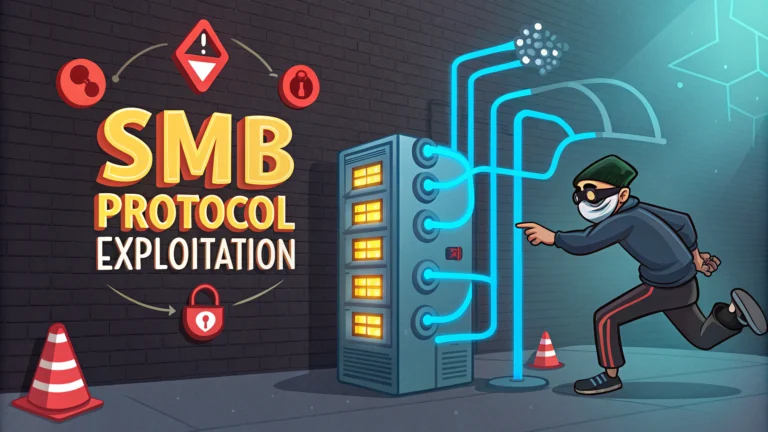The Server Message Block (SMB) protocol remains one of the most targeted network services during penetration tests and real-world attacks.
SMB provides file and printer sharing capabilities between Windows systems, making it a common entry point for network breaches.
Common SMB Vulnerabilities
- Outdated SMB versions (v1/v2) with known exploits
- Misconfigured share permissions
- Null sessions allowing anonymous access
- Weak or default credentials
- Unpatched systems vulnerable to EternalBlue (MS17-010)
SMB Enumeration Tools
- nmap – Port scanning and version detection
- enum4linux – Detailed Windows/Samba enumeration
- smbmap – SMB share mapping and permission checking
- CrackMapExec – SMB exploitation framework
Quick SMB Security Assessment Steps
- Detect SMB ports (TCP 139/445) using:
nmap -p139,445 [target] - Identify SMB version:
nmap -p445 --script smb-protocols [target] - Check for null sessions:
smbclient -L [target] -N - Map accessible shares:
smbmap -H [target] - Test for MS17-010:
nmap -p445 --script smb-vuln-ms17-010 [target]
Mitigation Strategies
- Disable SMBv1 on all systems
- Implement strong access controls on shares
- Use SMB signing and encryption
- Regular patching of Windows systems
- Network segmentation to limit SMB access
For direct SMB exploitation assistance, contact MITRE ATT&CK (T1021.002) or your local CERT team.
Tools for SMB Security Testing
| Tool | Purpose | Download Link |
|---|---|---|
| Impacket | SMB protocol manipulation | GitHub |
| Responder | SMB hash capture | GitHub |
| Metasploit | SMB exploitation | Official Site |
Remember to obtain proper authorization before testing SMB services on any network.
Advanced SMB Attack Prevention
- Implement Active Directory authentication controls
- Deploy honeypots to detect SMB scanning
- Monitor SMB traffic patterns with IDS/IPS
- Use file integrity monitoring on shared resources
- Enable comprehensive SMB logging
SMB Best Practices for Administrators
Configuration Hardening
- Restrict SMB to internal networks only
- Implement least-privilege access model
- Configure SMB encryption requirements
- Use dedicated service accounts
- Regularly audit share permissions
Monitoring and Response
- Set up alerts for failed authentication attempts
- Monitor for unusual SMB traffic patterns
- Create incident response playbooks for SMB attacks
- Maintain share access documentation
Conclusion
SMB security requires a multi-layered approach combining proper configuration, regular monitoring, and proactive vulnerability management. Organizations must maintain current patching levels, implement strong access controls, and regularly audit SMB services to prevent unauthorized access and data breaches.
Critical actions for maintaining SMB security:
- Regular security assessments of SMB infrastructure
- Implementation of recommended hardening measures
- Continuous monitoring and logging of SMB activities
- Employee training on secure file sharing practices
- Periodic review of SMB security policies
FAQs
- What is SMB Protocol and why is it a common target for exploitation?
SMB (Server Message Block) is a network file sharing protocol that allows applications to read, write, and request services from network servers. It’s commonly targeted because it’s widely used in Windows environments and has historically contained various vulnerabilities. - What are the most common SMB vulnerabilities that can be exploited?
Common SMB vulnerabilities include EternalBlue (MS17-010), SMBGhost (CVE-2020-0796), SMBleed (CVE-2020-1206), and null session attacks. These vulnerabilities can lead to remote code execution, information disclosure, or privilege escalation. - Which tools are most effective for SMB penetration testing?
Popular tools include Metasploit Framework, Nmap with SMB scripts, CrackMapExec, Impacket suite, and Enum4Linux. These tools can identify vulnerable SMB services, perform enumeration, and execute exploitation. - How can SMB version detection be performed during penetration testing?
SMB version detection can be performed using Nmap scripts (smb-protocols), Metasploit auxiliary modules, or direct banner grabbing. The command “nmap -p445 –script smb-protocols” is commonly used. - What is SMB relay attack and how does it work?
SMB relay attacks involve capturing SMB authentication requests and relaying them to another system to gain unauthorized access. Tools like Responder and ntlmrelayx can be used to perform these attacks. - How can organizations protect against SMB exploitation?
Protection measures include disabling SMBv1, implementing strong authentication, keeping systems patched, blocking SMB ports (139, 445) at the firewall, and using SMB signing to prevent relay attacks. - What are the signs that an SMB service is being exploited?
Signs include unusual network traffic on ports 139/445, unexpected authentication attempts, system crashes, high CPU usage, and suspicious outbound connections from compromised systems. - What role does null session enumeration play in SMB exploitation?
Null session enumeration allows attackers to retrieve information from Windows systems without authentication. It can reveal user lists, shares, and system information, serving as reconnaissance for further attacks. - How does SMB encryption affect penetration testing approaches?
SMB encryption (introduced in SMBv3) makes traditional sniffing attacks ineffective and requires different approaches, such as targeting misconfigurations or focusing on authentication mechanisms rather than direct protocol exploitation. - What is PsExec and how is it used in SMB exploitation?
PsExec is a legitimate SysInternals tool often used in SMB attacks to execute commands remotely. Attackers can use it or its variants to move laterally through networks once they have valid credentials.







